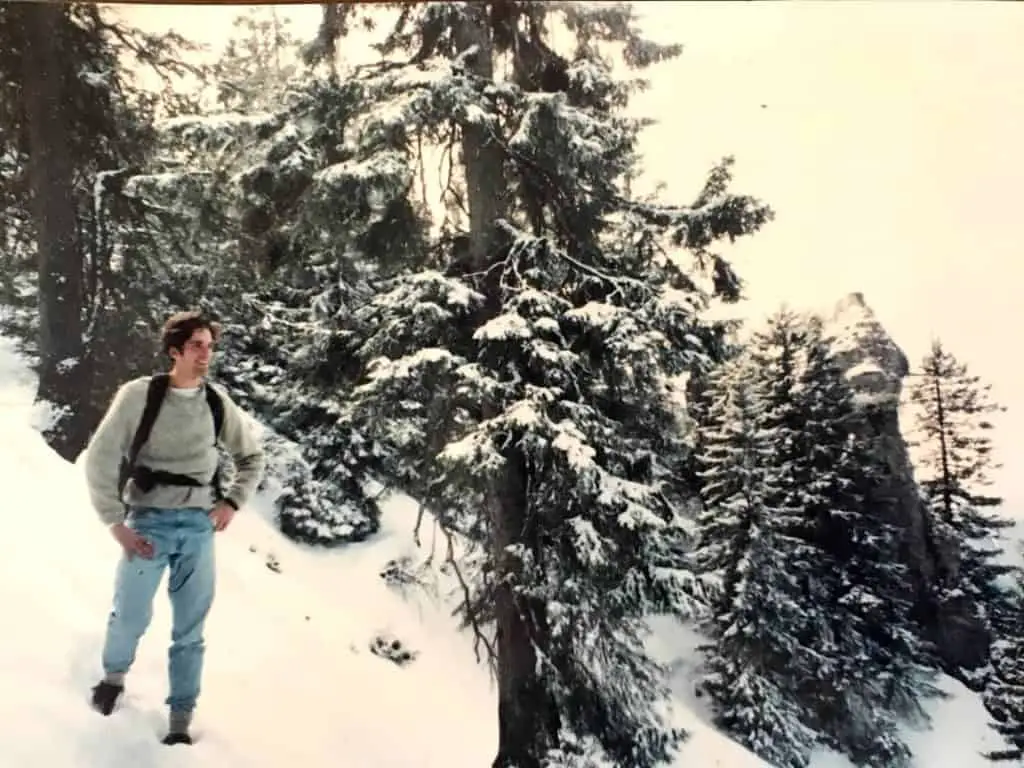Planning a hiking trip that lasts a single day or an entire week requires some preparation in advance. For a route covered in snow, you need to carefully consider some other factors before deciding to go on the hike. With proper planning and equipment, you can hike on the South Pole in snow deep enough to bury your home. For most people hiking in the snow is going to be a great experience if you consider for these four factors.
You can hike in the snow if you have the proper equipment. The depth of the snow is the most critical factor to consider. If the snow is deeper than halfway up your lower leg, then you will expend a considerable amount of energy to move forward.

1. Depth of the Snow.
If you have ever stepped into the snow and your legs disappeared, then you know that is is impossible to walk in these conditions. Just moving a few meters forward can require a herculean effort where you engage in something that looks more like dolphin diving than walking.
If the snow is deeper than the midpoint between the sole of your boot and your knee, then it won’t be easy to hike for any significant amount of time and cover the distances necessary to enjoy your hike. It will feel more like the training scene in Rocky IV, where he is carrying a log across his shoulders in the deep Siberian snow. The only difference is that you will be 30 feet from your vehicle and exhausted.
In my experience, if the depth of the snow is less than the midpoint of my lower leg, then I can make progress and enjoy the hike. If you are like most human beings, the distance from the bottom of your heel to the midpoint of your lower leg is also the length of your foot. For me, this is almost exactly 12 inches, and so if I hike in snow that is more than one foot deep, I begin to look like Sylvester Stallone carrying that log.
The deeper the snow gets over 12 inches, the more I have to change my gate to get my boots out over the top of the snow to take another step. On the other hand, as the snow diminishes in depth below twelve inches, it becomes easier and more comfortable to walk. At around six inches, or one-quarter up my lower leg, walking in snow is relatively easy and feels almost entirely normal. These snow depths will be different for everyone. If you bring small children, then even six inches of snow can have them doing Rocky IV training impersonations.
If the snow is bottomless and you must go on this hike, then you should consider buying or renting snowshoes. This article is about hiking in the snow, not snowshoeing.

2. Snow Conditions.
Snow is a complex substance that can take on many, many different forms. I was hiking in the Columbia River Gorge in Washington State in 1994 in December, and I encountered a type of snow that I had never seen before. It had snowed about eight inches the night before, but it was as if someone had covered the forest in styrofoam beads, and walking was not an issue because the snow was very light and did not compact.
On the other hand, I have walked in snow that was only three or four inches deep, and I risked mechanical injury. The snow was not deep, but it had a thick frozen crust on top that was strong enough to hold my weight for nine out of every ten steps. Every once in a while, I would break through to the fluffy snow below and lose my balance. Typically, adverse snow conditions are less common in new snow. If there have been multiple cycles of snow, melt, rain, and freezing, then you might have issues with more rigid and softer layers of snow that can be difficult or impossible to walk in.

3. Footwear and Socks.
For hiking in the snow, I recommend a pair of boots with some protection for your lower legs that keeps snow from infiltrating your shoes. Your boots do not have to be water-proof, but in that case, they should be treated to repel moisture. The key is to keep your feet dry. Having wet feet in a cold environment is not only miserable, but it can also be dangerous if you find yourself stranded or forced to stay outside in the cold for an extended period.
There are a few things you can to stop the snow from coming into your boots. If the snow is not deep enough to get into your footwear, then you should be fine, although snowdrifts can be impossible to spot, and you might find yourself buried up to your belt in the snow at a moment’s notice. Gaiters are ideal for snow hiking. You put them on over your boots and pants, and they keep your lower legs warm and dry while keeping snow out of your shoes.
Depending upon the type of boots you have, you can also make sure that the top of your boots is snug around your leg. This will limit the amount of snow that can enter. Be sure to check for gaps and tighten up your laces after you have been hiking for a while. Also, as much as possible, keep your pants over the top of your boots. I have pair of Vidda Pro trekking pants by Fjallraven that have a hook inside the bottom front of the leg that latches onto your boot laces, keeping them down over your boot.
You should also wear appropriate socks that will continue to keep your feet warm even if snow does enter your boot and causes moisture. Wool socks are ideal, but other synthetic-blend, winter hiking socks will do. I have many pairs of wool socks, similar to these from REI, that do double duty for hiking and skiing. Bring an extra pair of appropriate socks and keep them in a dry place in your coat or your backpack. My sister and I were hiking on Mt. Hood in Oregon in the winter, and while crossing a field, she broke through the snow into a mountain stream that was invisible to us. Her feet were frozen within a few minutes. We did not have an extra pair of socks for her. To warm up her feet, she placed them on my bare stomach. That is brotherly love.

4. Layered Clothing.
Layers are key. Hiking in the snow can be more difficult than on a dirt path. Even in colder temperatures, you might find yourself sweating as you walk through the snow. If you have layers of clothing then you can remove outer layers to regulate your body temperature. I recommend an outer shell that is waterproof, a layer for warmth, and an inner layer.
The out layer jacket should be able to keep you dry and keep the wind off of you. I am originally from Vancouver, Washington along the Columbia river, so I am partial to jackets by Columbia Sportwear. I have one of their Interchange jackets similar to this one. The inner layer can be a wool sweater or a down vest, anything that will warm up your core body temperature if you get cold. The Interchange jackets from Columbia provide both the outer layer and a removable liner for warmth. Finally, for the base layer next to your skin, I would splurge and get a quality thermal top. Silk is excellent, but wool blends or synthetics are good too. My wife bought me a pair of silk long underwear from REI for skiing that work great for hiking.
Your pants should be a material that will not easily get wet and will dry quickly. Obviously you want to stay warm but if you only have a pair of ripstop nylon hiking pants these will work if it is not too cold and you don’t plan on sitting still too long while hiking. You want to keep your core warm. In my experience, my legs are fine as long as they are dry and shielded from the wind. If your partner buys you those silk long underwear from REI then put those on under your hiking pants and you will be happy.
Hiking in the snow is a beautiful experience if you are prepared and consider these four factors before setting out. Hiking on your favorite trails in the snow is terrific because you can experience a familiar route with a completely different aesthetic. Sun can be a killer in the snow, so bring sunscreen and polarizing sunglasses. Finally, carry more water than you usually would if it is frigid. Cold weather dehydrates more quickly.

